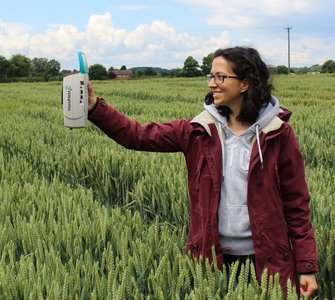Improving Wheat Crops in the Field

Complete the form below to unlock access to ALL audio articles.

Controlling diseases in wheat such as Septoria leaf blotch is vital for the cost-effective optimisation of yield. If it were possible to analyse the health of wheat crops at different stages of development and then adjust fungicide usage, farmers would be able to optimise fungicide input and improve their yields.
Being able to identify the early characteristics of disease during crop development is the subject of a three and a half year study of test field sites in Nottinghamshire, Cambridgeshire and South Wales. Co-funded by Innovate UK and BBSRC, a consortium comprising Agrii (provider of agronomy services), RAGT (plant breeders) and the University of Nottingham (crop and image analysis scientists) are running a project into this important challenge.
The ASD FieldSpec4 portable spectroradiometer from Analytik was chosen by the team to make on-site spectral reflectance measurements on wheat crops at each of the field sites. The reflectance data will be correlated with hyperspectral image data to aid final analysis. The ASD instruments were attractive due to their rugged and robust construction backed with no compromise in reliable spectrographic performance. Dr Rumiana Ray is an Associate Professor in Crop Pathology at the School of Biosciences at the University of Nottingham. Her research focus is on the development of integrative strategies for the control of root, stem-base, foliar and ear diseases in cereals. “We aim to identify novel hyperspectral and/or fluorescence signatures to probe crop health. If we are able to also differentiate responses in our varieties to disease and treatment then we can improve crop management decisions” said Dr Ray.
Leading the project on the ground is Agrii Head of R&D, David Langton. His beliefs demand integrated management of disease: “Thoroughly integrated management, employing an extended armoury of agronomic tools alongside the best available chemistry and varietal resistance has become every bit as essential in cost-effective wheat Septoria control as it is in tackling the scourge of black-grass. Just like black-grass, wheat growers can no longer afford to rely solely on chemical crop protection to counter the country's biggest cereal disease threat.”
The project sets out to explore and develop a number of innovative approaches to improving fungicide choice and spray timing decision-making at the three sites. Now in its second year, different wheat varieties are being tested biweekly. It is still early to define precise rules to maximize yield. The goal is to develop a diagnostic tool for the disease to aid decision making. This means a library of spectra is being collected. It is also important to get a good yield prediction as early as possible because that will influence the choice and application rate of fungicides to be used as well as total rate of nitrogen to apply. For example, if a good yield is forecasted for specific varieties, it would pay the grower to invest in a more robust fungicide application whereas a low yield forecast might help the choice not to invest as much. This is important for the environment too as the goal is to minimize nutrient and fungicide loss and potential pollution of soil and rivers. In total, the final decisions are based on a combination of an integrated crop and disease management which takes into account ROI and the environment.

